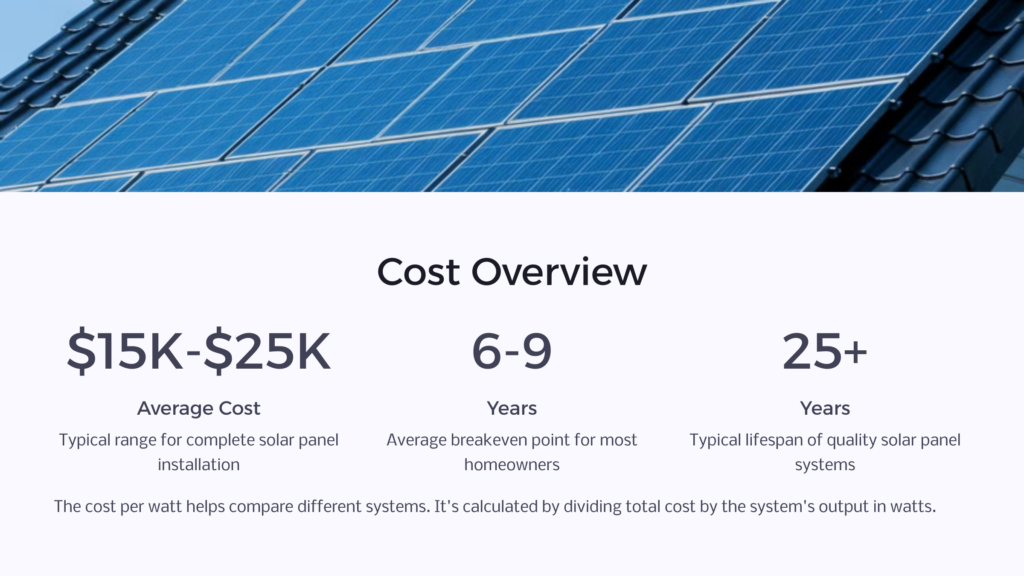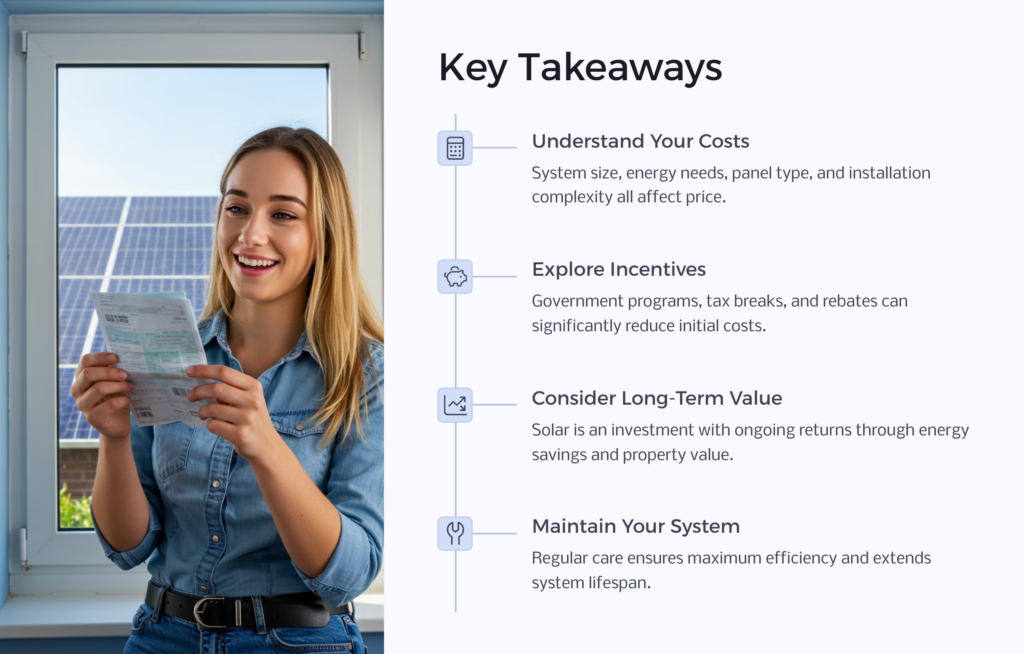Solar Panels Installation Cost
Solar panels, also known as photovoltaic (PV) systems, are devices that convert sunlight directly into electricity. They are a trending topic in our modern society as solar power represents a step towards a more sustainable and eco-friendly world. The importance of solar panels cannot be overstated. Besides being an excellent way to minimize carbon footprints with renewable energy, they offer a lasting solution to energy independence. This article will delve into the cost of solar panel installation and examine the factors behind the variance. We will also look at methods for cost reduction, discuss return on investment, and provide real-life examples.
Factors Affecting Solar Panels Installation Cost

Size of the System
The size of the solar panel systems plays a substantial role in determining the installation cost of the solar system. More considerable solar panel systems with higher wattage requirements necessitate the use of more solar panels to meet the energy needs. This increases the solar installation cost substantially.
Energy Consumption & Requirement
Another factor affecting the new installation’s price tag is the building’s energy consumption level. Homes with higher energy needs will require a larger solar energy system, and a larger solar installation cost.
Type of Solar Panel
The type of solar panel chosen also affects the average cost of installation. The two main types, crystalline silicon, and thin film, come at different price points, performance levels, and sizes.
Labor and Installation Costs
Installation costs and labor costs also contribute significantly to the total bill. Certain rooftop solar designs or complicated installations often increase labor costs for the solar installer.
Overview of Solar Panel Installation Cost

The average cost of solar panel installation typically ranges from $15,000-$25,000, although the overall cost can vary widely depending on the factors discussed earlier. The size, energy needs, type of panels, and installation complexity all have a significant impact on the total cost of setting up a solar panel system.
The Cost of Solar Panels Per Watt
The cost per watt of a solar energy system is calculated by dividing the solar system’s overall cost by the system’s energy output in watts. This measure is often used to compare the energy efficiency of different solar setups. The cost-per-watt measure is helpful for potential customers because it provides a standardized basis for comparison of solar panel efficiency.
Breakdown of Solar Panel Installation Cost
Equipment Costs
These include the solar panel cost, the solar battery, the solar inverter (which converts the solar power into usable electricity), and other necessary system and installation hardware.
Permitting and Inspection Fees
Solar panel installation requires permits and inspections to ensure compliance with local building, safety, and performance standards, especially for a rooftop solar panel system. Fees associated with these procedures add to the overall solar panel cost.
Installation and Labor
Professional solar installer companies will often do extensive site preparation and labor for a safe installation, contributing to the total cost.
Operational Costs & Maintenance
Solar panels usually require minimal maintenance, but any necessary upkeep, repairs, or potential replacements from a solar company will factor into the ongoing solar cost.
How to Reduce the Solar Cost
Government Incentives and Tax Breaks
Governments often offer solar incentives and tax breaks to encourage renewable energy adoption. Exploring these options can greatly reduce installation costs for business or residential solar panels.
Local and State Rebates
Similarly, some states and local governments provide tax rebates and solar incentives for solar installations, further reducing the initial solar panels cost.
Energy-Saving Programs and Initiatives
Many energy companies and environmental organizations run programs that offer grants, low-interest loans, or buyback programs for solar panel installations.
DIY Solar Panel Installation
For the hands-on homeowner, DIY solar panel installation can be a way to cut down on labor costs. However, this is a complex task that requires a specific skill set.
The Return on Investment of Solar Panels

The return on investment (ROI) for solar panels is calculated by comparing the cost of the system and installation to the savings accrued on energy bills over the lifespan of the system. Furthermore, the breakeven point arrives when the accumulated savings equal the initial outlay for the panels and their installation. The timeline varies, but many homeowners see a breakeven point between 6 and 9 years after installation.
Monitoring and Maximizing Solar Panel Efficiency
Regular monitoring and maintenance are essential to ensure optimal performance and longevity of solar panels. Cleaning panels, checking for shading issues, and monitoring energy production levels can help maximize energy efficiency and savings on your energy bill. Implementing these practices can contribute to a more energy efficient and cost-effective solar panel system.
The solar panels cost can vary quite a bit, influenced by several factors such as system size, energy requirements, type of panels, and labor costs. While the initial numbers can be substantial, there are numerous avenues – such as government incentives, local rebates, or even a solar loan – to reduce that expenditure significantly. Beyond cost, make sure to consider the long-term savings and increased value of the property. With a reasonable ROI and breakeven point, solar panels represent a sound investment for both financial and environmental reasons.

At Homeowner.org, we’re here to help. Get pre-approved today to either buy or refinance your home.
